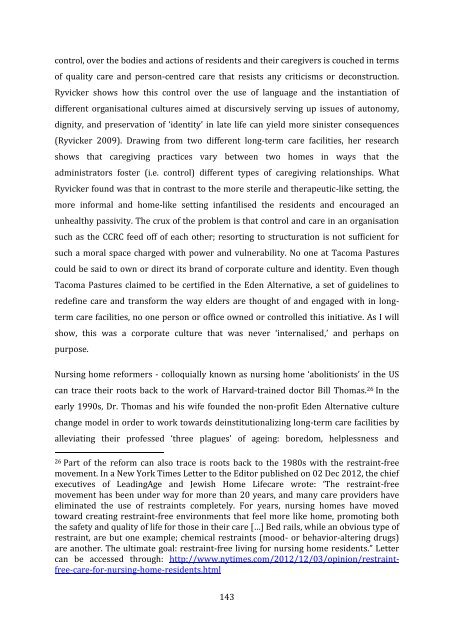Philip Y. Kao PhD thesis - Research@StAndrews:FullText
Philip Y. Kao PhD thesis - Research@StAndrews:FullText
Philip Y. Kao PhD thesis - Research@StAndrews:FullText
You also want an ePaper? Increase the reach of your titles
YUMPU automatically turns print PDFs into web optimized ePapers that Google loves.
control, over the bodies and actions of residents and their caregivers is couched in terms<br />
of quality care and person-centred care that resists any criticisms or deconstruction.<br />
Ryvicker shows how this control over the use of language and the instantiation of<br />
different organisational cultures aimed at discursively serving up issues of autonomy,<br />
dignity, and preservation of ‘identity’ in late life can yield more sinister consequences<br />
(Ryvicker 2009). Drawing from two different long-term care facilities, her research<br />
shows that caregiving practices vary between two homes in ways that the<br />
administrators foster (i.e. control) different types of caregiving relationships. What<br />
Ryvicker found was that in contrast to the more sterile and therapeutic-like setting, the<br />
more informal and home-like setting infantilised the residents and encouraged an<br />
unhealthy passivity. The crux of the problem is that control and care in an organisation<br />
such as the CCRC feed off of each other; resorting to structuration is not sufficient for<br />
such a moral space charged with power and vulnerability. No one at Tacoma Pastures<br />
could be said to own or direct its brand of corporate culture and identity. Even though<br />
Tacoma Pastures claimed to be certified in the Eden Alternative, a set of guidelines to<br />
redefine care and transform the way elders are thought of and engaged with in longterm<br />
care facilities, no one person or office owned or controlled this initiative. As I will<br />
show, this was a corporate culture that was never ‘internalised,’ and perhaps on<br />
purpose.<br />
Nursing home reformers - colloquially known as nursing home ‘abolitionists’ in the US<br />
can trace their roots back to the work of Harvard-trained doctor Bill Thomas. 26 In the<br />
early 1990s, Dr. Thomas and his wife founded the non-profit Eden Alternative culture<br />
change model in order to work towards deinstitutionalizing long-term care facilities by<br />
alleviating their professed ‘three plagues’ of ageing: boredom, helplessness and<br />
26 Part of the reform can also trace is roots back to the 1980s with the restraint-free<br />
movement. In a New York Times Letter to the Editor published on 02 Dec 2012, the chief<br />
executives of LeadingAge and Jewish Home Lifecare wrote: ‘The restraint-free<br />
movement has been under way for more than 20 years, and many care providers have<br />
eliminated the use of restraints completely. For years, nursing homes have moved<br />
toward creating restraint-free environments that feel more like home, promoting both<br />
the safety and quality of life for those in their care […] Bed rails, while an obvious type of<br />
restraint, are but one example; chemical restraints (mood- or behavior-altering drugs)<br />
are another. The ultimate goal: restraint-free living for nursing home residents.” Letter<br />
can be accessed through: http://www.nytimes.com/2012/12/03/opinion/restraintfree-care-for-nursing-home-residents.html<br />
143
















